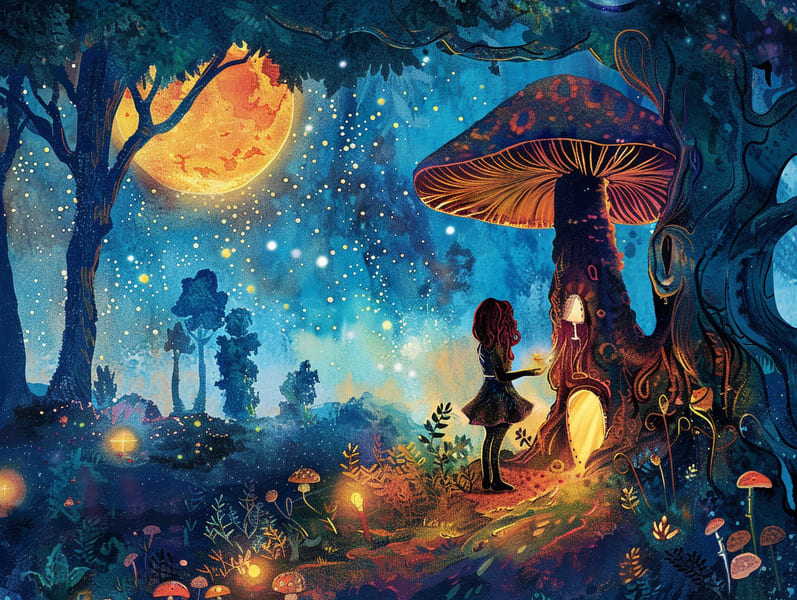
Popular fairy tales have long histories. These narratives have been shared from one generation to the next centuries before they were ever written down. They originated from a variety of backgrounds, including Western traditions. They were initially narrated among older generations, often carrying themes and messages reflective of the societal norms and beliefs of the time.
The renowned Brothers Grimm, the two Grimm brothers, were among the first to collect many of these beloved narratives. Their published works, "Grimm's Fairy Tales," included classics like "Cinder Maid," "Hansel and Gretel," and "Schneewittchen," which have since become classics in the world of famous fairy tales. Similarly, Hans Andersen's fanciful tales, such as "The Sea Maid," and "The Story of the Ugly Duckling," have floated into hearts worldwide, solidifying their place in the pantheon of iconic fairy tales.
Though they are centuries old, these stories remain as significant as ever, especially as children's bedtime stories. These charming stories are now available in various formats, including richly illustrated books, fantastical animations, and web-based fairy tales.
Their lasting presence can be linked to several enchanting factors:
Valuable Lessons: Traditional fairy tales often teach important moral lessons. Tales like "The Wolf and the Liar" teach the merit of integrity, while "The Hare and the Tortoise" illustrate the traits of resolve and unpretentiousness. These tales offer kids clear distinctions between right and wrong, molding their moral compass in a gentle yet important way.
Compassion and Knowledge: Old fairy tales frequently portray heroines facing difficulties and adversities, stimulating children to identify with their struggles and encourage their triumphs. For instance, "Beauty's Beast" teaches us the merit of seeing inner beauty to recognize the true character of a being, nurturing insight and knowledge.
Cultural Understanding: Many classic fairy tales are deeply ingrained in the cultural contexts from which they blossomed. Exploring these stories can provide fascinating glimpses into different social structures, encouraging a sense of cultural insight and knowledge.
Fantasy and Innovation: The imaginative elements in classic fairy tales—supernatural elements—unleash children’s dreaming abilities. These stories bring readers to fantastical realms, activating innovative dreams and a sense of marvel that lasts a lifetime.
Classic fairy tales are not only entrancing but also pedagogical. They work as whimsical tools in cultivating various brain and heart skills in young ones. When ancient fairy tales are narrated, they enhance language acquisition by showing new language and sophisticated sentence structures. This practice also promotes auditory skills and attention, as children hang on every word, enthusiastic to see what happens next.
Furthermore, debating the themes and characters of fairy tales can nurture problem-solving abilities and thought processes. Young ones learn to spot patterns, guess what will happen, and comprehend cause and effect. These analyses also contribute to kids verbalize their thoughts and feelings, cultivating their emotional intelligence.
In today’s modern era, the existence of digital storybooks has made these fairy tales more available than ever. Websites and digital apps extend broad selections of Grimm's fairy tales that can be browsed or played anytime, anywhere. Fairy tales spoken are particularly prevalent, extending an delightful method for kids to delight in these charming stories. Audio stories and narrated videos transport characters and settings to life, often supplemented by whimsical background sounds and soundtracks that intensify the tale experience.
The timeless appeal of old fairy tales lies in their ability to evolve to today's society while staying true to their essential themes. Contemporary updates of these stories often highlight more different protagonists and modern settings, making them meaningful to today’s audience. However, the basic principles of spirit, warmth, and justness remain unchanged, continuing to influence listeners of all ages.
Fairy tales also offer a sense of familiarity and knowability. They allow a systematic narrative with a clear beginning, middle, and end, often finishing with the finalization of conflicts and the triumph of good over evil. This predictability can be comforting for young ones, presenting a sense of invariability in an ever-changing Grimm's fairy tales collection world.
Traditional fairy tales continue to allure and instruct new generations, maintaining their enchantment and meaningfulness in modern society. As children's night stories, they render accessible a perfect blend of enchantment and education, sustaining moral values, empathy, and creativity. The availability of online storybooks and the well-received status of fairy tales voiced secure that these old stories remain within reach to new generations.
By maintaining and divulging these fairy tales, we continue to value the rich tapestry of mythology and cultural heritage. Whether you are seeing a beautifully illustrated book, experiencing a virtual library, or playing an narrated book, the mystique of bedtime fairy tales is always within reach. These fairy tales convey of the endless presence of fairy tales and its ability to bind us across eras and regions.
If you are perusing a artistically illustrated book, discovering a web-based collection, or listening through an voice book, the wonder of bedtime fairy tales is always within reach.
These narratives demonstrate of the enduring power of fairy tales and its ability to link us across generations and cultures, making a tie that enchants and educates alike.